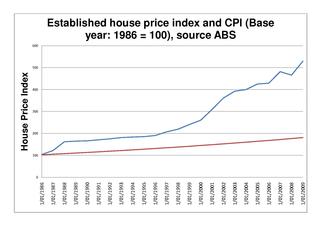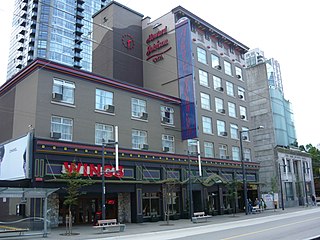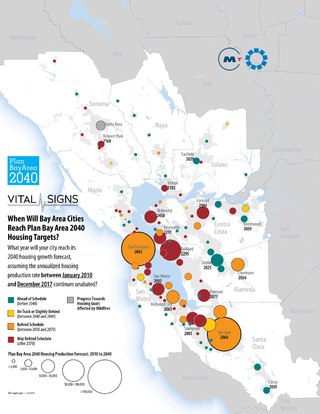The Australian residential property market is the section of the Australian property market that provides rental properties by landlords to tenants. In Australia 31% of households rent their residences. [1] The vast majority rent from private landlords, and a small minority rent from public housing authorities. Over the last three decades the proportion of Australians in public housing has halved, whilst the amount renting privately has grown. [1] [2] The average weekly price for a rental in Australia is $570 AUD. [3] Sydney has the most expensive capital city rents. [4] Rental rates have increased faster than inflation in recent years. [3] [5]
In recent years, the cost of Australian rentals has become a prominent political issue; dubbed the 'rental crisis'. Demand remains high while supply is low. [4] Some have advocated supply-side reforms to address the crisis, such as reforms to construction approvals, [6] others for price controls, [7] and others for demand-side reforms like immigration restrictions. The actions of Australia's major parties on the issue have been widely criticised as inadequate, [8] though praised by some. [9]
Around one third of Australia's 9.8 million households pay rent for their residences. The other two thirds are owner-occupiers, half of whom have a mortgage. [1] [2] [Note 1] Of the households that rent, ~83% rent from private landlords, while less than 10% rent from public housing authorities. [2] [Note 2] The proportion of households from a public housing authority has approximately halved since 1995, while the proportion renting from a private landlord has increased by over ~40%. [2]
Immigrants overwhelmingly settle in Sydney and Melbourne, exacerbating the shortage of supply in those cities. [10]
The average weekly price for a rental in Australia is $570 per week. Units are typically cheaper, at a national median of $540 vis-a-vis houses at $582. [3] Rental prices grew nationally by 10.1% between 2022 and 2023; substantially higher than the annualised CPI rate of 7% for the period. [3] [5] Vacancy rates are historically quite low, at around 1%; a rate some argue is indicative of upward price pressure. [11]
Median rents across Australian cities as of Q1 2023 is as follows: [3]
| Region | Median Rent (per week) | Gross yields [Note 3] | Vacancy rates [Note 4] |
|---|---|---|---|
| Sydney | $699 | 3.22% | 1.2% |
| Melbourne | $526 | 3.4% | 0.7% |
| Brisbane | $599 | 4.34% | 1.1% |
| Adelaide | $531 | 4.09% | 0.3% |
| Perth | $572 | 4.85% | 0.6% |
| Hobart | $563 | 4.39% | 1.7% |
| Darwin | $588 | 6.39% | 1.8% |
| Canberra | $674 | 4.19% | 2.0% |
| National | $570 | 3.9% | 1.2% |
Rental availability and affordability has become a prominent issue in Australian Politics recently, with the topic being the subject of substantial media coverage and political debate. [12] [13] [14] [15] Media reports have included coverage of low income households being unable to find suitable accommodation and forced into homelessness. [16] [17] Some suburbs in Australia saw rent increase between 30-40% from 2020 to 2022; [17] with Bellingen on the NSW coast experiencing an annual rent increase of 48%. [18] In September 2023, the national vacancy rate declined to 1.1%. [19]
Reasons provided for the crisis vary, with some blaming failures in residential construction processes at the council level, [20] a lack of public housing construction, [21] vacant residences, [22] increases in short-stay accommodation [23] or demand factors like immigration. [12] Reductions in average household size during the Covid-19 pandemic have also been pointed for driving a demand squeeze. The pandemic has prompted a desire for more space and to live with fewer people. [24]
Solutions proposed to address Australia's rental crisis also vary. Some economists have proposed reforms to residential construction approval process, [6] while others (most notably the Australian Greens) have proposed an introduction of rent controls. [7] Major parties proposals at a national level to address the issue have included a scheme proposed by the ALP called the 'social housing fund', [25] whilst The Coalition has promoted assistance schemes to increase rates of home-ownership. The responses of Australia's major parties have been criticised as inadequate. [26] [8] [27]
In the United States, rent control refers to laws or ordinances that set price controls on the rent of residential housing to function as a price ceiling. More loosely, "rent control" describes several types of price control:
A real-estate bubble or property bubble is a type of economic bubble that occurs periodically in local or global real estate markets, and it typically follows a land boom. A land boom is a rapid increase in the market price of real property such as housing until they reach unsustainable levels and then declines. This period, during the run-up to the crash, is also known as froth. The questions of whether real estate bubbles can be identified and prevented, and whether they have broader macroeconomic significance, are answered differently by schools of economic thought, as detailed below.
Jeonse, also known as chŏnse, key money deposit or key money, is a type of lease or deposit common in the South Korean real estate market. Instead of paying monthly rent, a renter will make a lump-sum deposit on a rental space, at anywhere from 50% to 80% of the market value, which is then returned at the end of the lease term. The owners make profit from reinvesting the jeonse deposit, instead of receiving the monthly rent. It is also possible to combine a lower jeonse with a small monthly rent.

Affordable housing is housing which is deemed affordable to those with a household income at or below the median as rated by the national government or a local government by a recognized housing affordability index. Most of the literature on affordable housing refers to mortgages and a number of forms that exist along a continuum – from emergency homeless shelters, to transitional housing, to non-market rental, to formal and informal rental, indigenous housing, and ending with affordable home ownership.
Rental value is the fair market value of property while rented out in a lease. More generally, it may be the consideration paid under the lease for the right to occupy, or the royalties or return received by a lessor (landlord) under a license to real property. In the science and art of appraisal, it is the amount that would be paid for rental of similar real property in the same condition and in the same area.

Public housing in Australia is one part of social housing and the other is community housing. Public housing is provided by departments of state governments. Australian public housing operates within the framework of the Commonwealth-State Housing Agreement, by which funding for public and community housing is provided by both federal and state governments. According to the 2006 census, Australia's public housing stock consisted of some 304,000 dwellings out of a total housing stock of more than 7.1 million dwellings, or 4.2% of all housing stock.
Rent regulation in New York is a means of limiting the amount of rent charged on dwellings. Rent control and rent stabilization are two programs used in parts of New York state. In addition to controlling rent, the system also prescribes rights and obligations for tenants and landlords.

Home ownership in Australia is considered a key cultural icon, and part of the Australian tradition known as the Great Australian Dream of "owning a detached house on a fenced block of land." Home ownership has been seen as creating a responsible citizenry; according to a former Premier of Victoria: "The home owner feels that he has a stake in the country, and that he has something worth working for, living for, fighting for."

Housing, or more generally, living spaces, refers to the construction and assigned usage of houses or buildings individually or collectively, for the purpose of shelter. Housing is a basic human need, and it plays a critical role in shaping the quality of life for individuals, families, and communities.

The Australian property market comprises the trade of land and its permanent fixtures located within Australia. The average Australian property price grew 0.5% per year from 1890 to 1990 after inflation, however rose from 1990 to 2017 at a faster rate and may be showing signs of a contracting economic bubble. House prices in Australia receive considerable attention from the media and the Reserve Bank and some commentators have argued that there is an Australian property bubble.

The Australian property bubble is the economic theory that the Australian property market has become or is becoming significantly overpriced and due for a significant downturn. Since the early 2010s, various commentators, including one Treasury official, have claimed the Australian property market is in a significant bubble.
The Ellis Act is a 1985 California state law that allows landlords to evict residential tenants to "go out of the rental business" in spite of desires by local governments to compel them to continue providing rental housing.

Affordable housing in Canada is living spaces that are deemed financially accessible to those with a median household income in Canada. The property ladder continuum of affordable housing in Canada includes market, non-market, and government-subsidized housing.
Rent regulation is a system of laws, administered by a court or a public authority, which aims to ensure the affordability of housing and tenancies on the rental market for dwellings. Generally, a system of rent regulation involves:
The Costa–Hawkins Rental Housing Act ("Costa–Hawkins") is a California state law, enacted in 1995, which places limits on municipal rent control ordinances. Costa–Hawkins preempts the field in two major ways. First, it prohibits cities from establishing rent control over certain kinds of residential units, e.g., single-family dwellings and condominiums, and newly constructed apartment units; these are deemed exempt. Second, it prohibits "vacancy control", also called "strict" rent control. The legislation was sponsored by Democratic Senator Jim Costa and Republican Assemblymember Phil Hawkins.

Starting in the 1990s, the city of San Francisco, and the surrounding San Francisco Bay Area have faced a serious housing shortage, such that by October 2015, San Francisco had the highest rents of any major US city. San Francisco's onerous permitting and approval processes have given city the slowest permitting process of any large city in the United States, with the first stage taking an average of 450 calendar days, and the second stage taking 630 days for typical multi-family housing, or 860 days for a single-family house, and the second-most expensive construction costs in the world.

Affordable housing is housing that is deemed affordable to those with a median household income as rated by the national government or a local government by a recognized housing affordability index. A general rule is no more than 30% of gross monthly income should be spent on housing, to be considered affordable as the challenges of promoting affordable housing varies by location.

Cancel rent is a slogan and tenant rights movement in the United States, which advocates for the cancellation of rental payments and suspension of mortgage payments during the coronavirus pandemic. Activists and organizations have also presented other demands, which include the cancellation of housing-related expenses, cancellation of late fees for housing payments, the establishment of a landlord hardship fund, an increase in emergency housing, and an eviction moratorium. The movement was triggered by the economic impact of the pandemic, in which mass business closures and employee layoffs resulted in financial insecurity for many Americans. Tenants faced a range of issues, including the inability to pay rent, harassment or intimidation from landlords, and potential eviction. This situation put tenants at risk of damaged credit ratings, food insecurity, and homelessness. Consequently, activists, tenants rights organizations, and some politicians have called for the cancellation of rent.

The majority of Americans (64%) own their own homes, a rate that is less than the home ownership rates other large countries such as China (90%), Russia (89%), Mexico (80%), or Brazil (73%).
Judith Nancy Yates was an Australian housing economist. She was a lecturer and associate professor at the University of Sydney from 1971 to 2009. As a social liberal economist, she published over 120 papers in academic journals and government and industry reports on most aspects of Australia's housing sector, most notably on distributional aspects of the tax and finance system, on affordability and the supply of low-rent housing.Throughout her career she was appointed to a number of government advisory committees, and she contributed to many government inquiries.